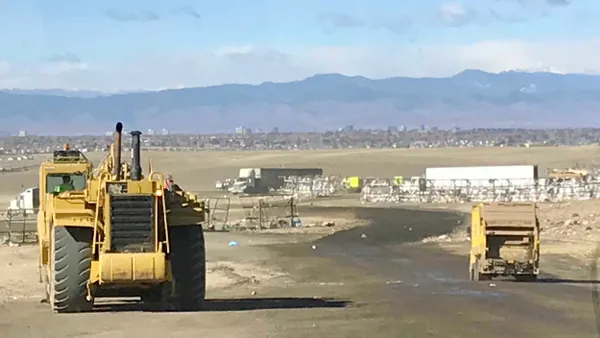Dive Brief:
- A new study put out by the Solid Waste Association of North America (SWANA) documents benefits of two nontraditional final capping methods for non-hazardous landfills.
- The study looked at exposed geomembrane systems (EGC) and engineered turf cover systems (ETC), and found that they have service lives of about 100 years and about 200 years, respectively. The Environmental Protection Agency's (EPA) prescribed method for capping landfills include a vegetative surface layer that can be costly to maintain for the requisite 30 years after a landfill is capped.
- "The most important finding is that state regulatory agencies are approving these systems as final cover systems," Jeremy O'Brien, director of SWANA's Applied Research Foundation (ARF), said in an interview with Waste Dive.
Dive Insight:
O'Brien said that concerns about differential settlement, soil erosion and maintenance cost spurred the ARF study. The report, according to a press release, found that ETC and EGC have "real potential" to meet or exceed federal requirements while offering "flexibility" and allowing for optimization.
Neither system meets the EPA's prescribed method for capping landfills. However, SWANA found that a handful of states accept EGC or ETC landfill covers. Florida, Georgia, Louisiana, Maryland and Oregon accept EGC as final landfill covers; California, Connecticut, Florida, Louisiana, Minnesota, Missouri, Pennsylvania, South Carolina, Tennessee and Virginia accept ETC as final landfill covers, according to O'Brien. Not-prescribed by the EPA doesn't mean forbidden.
"When we close these landfills, we are required by regulations to take care of them for 30 years," O'Brien said. "A lot of post-care expense ends up being maintaining the vegetation. That's why there's an interest in two non-vegetative cover systems."
In the states that don't accept EGC or ETC, O'Brien said, the 30-year maintenance period doesn't begin until the EPA prescribed method is used to cover a landfill — which can create excessive maintenance costs. EGC and ETC systems could offer significant savings for landfill operators, especially if more states, or even the EPA, begin to recognize the methods as final covers.









